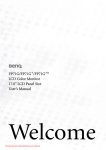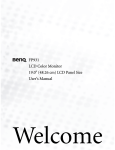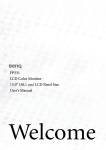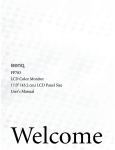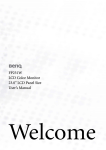Download BenQ FP71G User's Manual
Transcript
FP71G/FP71G+ LCD Color Monitor 17.0" (43.2 cm) LCD Panel Size User’s Manual Welcome i Copyright Copyright © 2004 by BenQ Corporation. All rights reserved. No part of this publication may be reproduced, transmitted, transcribed, stored in a retrieval system or translated into any language or computer language, in any form or by any means, electronic, mechanical, magnetic, optical, chemical, manual or otherwise, without the prior written permission of BenQ Corporation. ii Disclaimer BenQ Corporation makes no representations or warranties, either expressed or implied, with respect to the contents hereof and specifically disclaims any warranties, merchantability or fitness for any particular purpose. Further, BenQ Corporation reserves the right to revise this publication and to make changes from time to time in the contents hereof without obligation of BenQ Corporation to notify any person of such revision or changes. Please follow these safety instructions for best performance, and long life for your monitor iii Power Safety • The AC plug isolates this equipment from the AC supply. • The power supply cord serves as a power disconnect device for pluggable equipment. The socket outlet should be installed near the equipment and be easily accessible. • This product should be operated from the type of power indicated on the marked label. If you are not sure of the type of power available, consult your dealer or local power company. iv Care And Cleaning • Cleaning. Always unplug your monitor from the wall outlet before cleaning. Clean the LCD monitor surface with a lint-free, non-abrasive cloth. Avoid using any liquid, aerosol or glass cleaners. • Slots and openings on the back or top of the cabinet are for ventilation. They must not be blocked or covered. Your monitor should never be placed near or over a radiator or heat source, or in a built-in installation unless proper ventilation is provided. • Never push objects or spill liquid of any kind into this product. v Servicing • Do not attempt to service this product yourself, as opening or removing covers may expose you to dangerous voltages or other risks. If any of the above mentioned misuse or other accident such as dropping or mishandling occurs, contact qualified service personnel for servicing. 2 i Table of Contents Getting started ...................................................................................................................... 4 Getting to know your monitor ............................................................................................ 5 Front View ...................................................................................................................5 Back View .....................................................................................................................5 How to install your monitor hardware ............................................................................... 6 How to detach the stand base ........................................ 9 How to install your monitor’s software ............................................................................ 10 Choosing the best picture resolution ................................................................................. 14 How to choose the right Refresh Rate ............................................................................... 16 How to set the Picture Optimization ................................................................................ 19 How to adjust your monitor .............................................................................................. 20 A Look at the Control Panel .....................................................................................20 Hot Key Mode ...........................................................................................................20 Main Menu Mode ......................................................................................................21 Troubleshooting ................................................................................................................. 28 Frequently Asked Questions (FAQ) .........................................................................28 Need More Help? .......................................................................................................29 Supported operating modes ............................................................................................... 30 Specifications ...................................................................................................................... 31 3 111 1Getting started When unpacking please check you have the following items. If any are missing or damaged, please contact the place of purchase for a replacement. BenQ LCD Monitor Quick Start Guide 00 2 CD-ROM P / N : 5 3.L 9 00 3. Power Cord Signal Cable: D-Sub Warranty Card Getting started 4 121 1Getting to know your monitor Front View Back View 1 1. Power AC input jack 2. Video signal input jack 5 Getting to know your monitor 2 131 1How to install your monitor hardware If the computer is turned on you must turn it off before continuing. Do not plug-in or turn-on the power to the monitor until instructed to do so. 1. Attach the monitor base. Please be careful to prevent damage to the monitor. Placing the screen surface on an object like a stapler or a mouse will crack the glass or damage the LCD substrate voiding your warranty. Sliding or scraping the monitor around on your desk will scratch or damage the monitor surround and controls. Protect the monitor and screen by clearing a flat open area on your desk and placing a soft item like the monitor packaging bag on the desk for padding. Lay the screen face down on a flat clean padded surface. Whilst holding the monitor firmly against the desk, pull the monitor stand arm upwards clear of the monitor. Orient and align the stand base socket with the end of the stand arm, then push them together until they click and lock into place. Gently attempt to pull them back apart to check that they have properly engaged. Carefully lift the monitor, turn it over and place it upright on its stand on a flat even surface. You should position the monitor and angle the screen to minimize unwanted reflections from other light sources. -5 2. Connect the video cable. Connect the plug of the D-Sub cable (at the end without the ferrite filter) to the monitor D-Sub socket. Connect the other plug of the D-Sub cable (at the end with the ferrite filter) to the computer video D-Sub socket. Tighten all finger screws to prevent the plugs from accidently falling out during use. How to install your monitor hardware 6 3. Connect the power cable to the monitor. Plug one end of the power cord into the socket labelled ’POWER IN’ on the rear of the monitor. Do not connect the other end to a power point just yet. 4. Route the cables via the loose bracket. Release the cable retaining clip by squeezing the clip inwards as illustrated. Position the cables together and reinsert the clip over them to retain the cables neatly in place behind the monitor stand. 7 How to install your monitor hardware 5. Connect-to and turn-on the power. Plug the other end of the power cord into a power point and turn it on. Turn on the monitor by pressing the power button on the front of the monitor. Turn on the computer too, and follow the instructions in Section 4: How to install your monitor's software to install the monitor software. How to install your monitor hardware 8 How to detach the stand base 1. Prepare the monitor and area. Turn off the monitor and the power before unplugging the power cable. Turn off the computer before unplugging the monitor signal cable. Please be careful to prevent damage to the monitor. Placing the screen surface on an object like a stapler or a mouse will crack the glass or damage the LCD substrate voiding your warranty. Sliding or scraping the monitor around on your desk will scratch or damage the monitor surround and controls. Protect the monitor and screen by clearing a flat open area on your desk and placing a soft item like a towel on the desk for padding, before laying the screen face down on a flat clean padded surface. 2. Release the locking clip on one side of the stand base whilst pulling the edge of the base away from the stand arm. 3. Release the other locking clip to detach the stand base from the monitor stand arm. 9 How to install your monitor hardware 141 1How to install your monitor’s software You need to set up the correct monitor driver to suit your operating system. To set up Windows 98, start on this page. Windows 2000, turn to page 11. Windows ME turn to page 12. Windows XP turn to page 13. Windows 98. To manually install or update the driver, perform the following steps: 1. Open the control panel and double-click “Display” icon. 2. From the “Display Properties” window, select the “Settings” tab. Click the “Advanced...” button in the bottom right corner. 3. Select the “Monitor” tab. Click the “Change” button in the top right corner. 4. The “Update Device Driver Wizard” opens. Confirm by clicking “Next”. 5. Select “Display a list of all drivers in a specific location, so you can select the driver you want.” and press “Next”. 6. Now click the “Have Disk” button in the bottom right corner. Another window appears. Select the “Browse” button. 7. Insert the supplied CD into your computer. Select the CD-drive from the drop-down menu. 8. By pressing “OK” again in the next window you will be given a list of compatible devices. Select “FP71G” from the list and press “Next” again. 9. An “Insert Disk” dialogue box appears. Click “OK”, and then click “Skip File”. 10. Close “Update Device Driver Wizard” by clicking “Finish” to complete the installation. How to install your monitor’s software 10 Windows 2000. The first time you start Windows with a new monitor, the system will detect it and automatically start the “Add New Hardware Wizard”. Carry out the instructions beginning at step 4. 1. Insert “BenQ LCD Monitor” CD-ROM into your CD-ROM Driver. 2. Click “Start” then “Settings”. 3. Open the Control Panel and double click on the “Display” icon. 4. From the “Display Properties” window, select the “Settings” tab. Click the “Advanced Properties” button in the bottom right corner. 5. Select “Monitor” then click “Properties”. 6. Select “Driver” tab then click “Update Driver”. 7. The “Upgrade Device Driver Wizard” will pop up. Then click “Next”. 8. Select “Display a list of the known drivers for this device so that I can choose a specific driver” then click “Next”. 9. In the next window, click “Have Disk”, then “Install From Disk” window will pop up. Click “Browse”, the “Located File” will pop up. 10. Scroll down and select your CD ROM Driver, then click “Next” . 11. In the list of folders within the CD-ROM, select “Drivers” folder then click “Open” twice, then click “OK”. Select your LCD Mode (FP71G) from the list in the next window then click “Next” twice. 12. The new drivers are now installed on your computer. 11 How to install your monitor’s software Windows ME. To manually install or update the driver, perform the following steps: 1. Click “Start”, “Settings”, “Control Panel” and then double-click “Display”. 2. In the Display Properties window, click the “Settings” tab and click “Advanced...”. 3. Click the “Monitor” tab and then click “Change”. 4. “Update Device Driver Wizard” dialogue box appears. Choose “Specify the location of the driver (Advanced)” and then click “Next”. 5. Choose “Display a list of all the drivers in a specific location, so you can select the driver you want” and click “Next”. 6. Choose “Monitor” from the list and then click “Next”. 7. Choose “Display a list of all the drivers in a specific location, so you can select the driver you want.”. 8. Click “Have disk” and then click “Browse...”. 9. Insert “BenQ LCD Monitor’s CD” into your CD-ROM and type d:\ (change the driver letter to match your CD-ROM driver if it is not drive D). Enter “Drivers” folder to select the model from the list left. Click “OK”. 10. Click “OK” on the “Install From Disk” window. The dialogue box “Update Device Driver Wizard” appears. Choose the model from the list, then click “Next”. 11. Click “Next”. 12. Click “Finish” to complete the installation. How to install your monitor’s software 12 Windows XP. 1. Right click mouse on the desktop and choose “Properties”. Select “Settings” tab and click the “Advanced” button. A small window will pop up. Select the “Monitor” tab in the new window and then click “Properties”. 2. Select “Driver” tab and then click “Update Driver…” 3. The “Hardware Update Wizard” will pop up. Then click “Next”. 4. Select “Don’t search. I will choose the driver to install” and then click “Next”. 5. In the next window, click “Have Disk…”, an “Install From Disk” window will pop up. Click “Browse”. The “Locate File” window will pop up. 6. Select your driver and then click “Next”. 7. The new drivers are now installed to your computer. Click “Finish” to exit installation. 13 How to install your monitor’s software 151 1Choosing the best picture resolution Due to the nature of LCD display technology, the picture resolution is always fixed. The best picture possible for your FP71G/FP71G+ is achieved with a resolution of 1280x1024. This is called “Native Resolution” or maximal resolution - that is, the clearest picture. Lower resolutions are displayed on a full screen through an interpolation circuit. However flaws do occur with the interpolated resolution. So if you want to have all the advantages of LCD technology you must use the native resolution. If you are using Windows 98/2000/ME or XP you can change the picture resolution as follows: 1. Double-click the “Display” icon in the Control Panel. 2. From the “Display Properties” window, select the “Settings” tab. You can alter the resolution by using the slider on the right-hand side. Choosing the best picture resolution 14 3. Select a resolution of 1280x1024. Then click “Apply”. 4. In the subsequent windows, press “OK” and “Yes” 5. You can now close “Display Properties”. 15 Choosing the best picture resolution 161 1How to choose the right Refresh Rate You don’t have to choose the highest possible refresh rate on an LCD display, because it is not technically possible for an LCD display to flicker. The best results are obtained by using the factory modes already set in your computer. There is a table with the factory modes in this user’s guide. Youc an choose 60, 70 and 75 Hertz, (but not 72Hz) for the native resolution of 1280x1024. In Windows 98/2000/ME/XP you can change the refresh rate as follows: 1. Double click the “Display” icon in the Control Panel. How to choose the right Refresh Rate 16 2. From the “Display Properties” window, select the “Settings” tab. Click the “Advanced...” button in the bottom right corner. 17 How to choose the right Refresh Rate 3. Select the “Adapter” tab. The refresh rate selection field is located in the center at the bottom of the window. 4. Choose a refresh rate from the table with the factory modes, which can be found in the user’s guide, and select this in the settings field. 5. In the subsequent windows press “Change”, “OK” and “Yes”. 6. You can now close “Display Properties”. How to choose the right Refresh Rate 18 171 1How to set the Picture Optimization The easiest way to obtain an optimal display is to use the ikey function. Press the “ikey” on the control panel and the monitor will adjust automatically. If you are still not satisfied with the result, you can still adjust the image manually. 1. Run the test program auto.exe from CD-ROM; this is the best way to observe possible changes. You can also use any other image, such as the desktop of your operating system. However, we recommend that you use auto.exe. As you run auto.exe, a test pattern emerges. 2. Press “Enter” on control panel to access OSD. 3. If there is vertical noise observed, press W or X key to select “Geometry” and press “Enter” key. Then press W or X key to select “Pixel Clock” and also press “Enter” key again. Now, press W or X key to adjust the monitor untill the noise disappears. 4. If there is horizontal noise observed, press W or X key to select “Geometry” and press “Enter” key. Then press W or X key to select “Phase” and also press “Enter” key again. Now, press W or X to adjust the monitor untill the noise disappears. To make sure the “iKey” function performs well, you have to use one of the supported modes. If the “iKey” does not work properly and the “NON PRESET MODE” message is on the OSD, it means you are not using one of the supported modes. Please set your computer to use one of the supported modes. You will find a list of supported modes in this manual. 19 How to set the Picture Optimization 181 1How to adjust your monitor A Look at the Control Panel 1 2 3 4 5 6 There are 6 keys for user’s control including “iKey”, “Exit”, “Enter”, “<” and “>” key and a power swith. The following descriptions are the introduction of these keys & switch. 1. “iKey” : Adjust vertical position, phase, horizontal position and pixel clock automatically. 2. “Exit” key: Back to previous menu or exit OSD. 3. W (Left) key: For Left/Decrease adjustment. Left key is the hot key for Contrast. 4. X (Right) key: For Right/Increase adjustment. Right key is the hot key for Brightness. 5. “Enter” key: Activate OSD, enter sub menu, select items, confirm selection and hot key for OSD Lock. 6. “Power”: Turn the power on or off. Hot Key Mode Brightness and Contrast hot key Press X to enter Brightness menu, press W or X key to adjust the degree of brightness and press “Exit” to exit OSD. Press W to enter Contrast menu, press W or X key to adjust the degree of Contrast and press “Exit” to exit OSD. How to adjust your monitor 20 Main Menu Mode Control Functions Available in Main Menu Main Menu Luminance sub menu Press W or X key to adjust the degree of Brightness, press “Exit” to return to the previous menu. Press W or X key to adjust the degree of Contrast, press “Exit” to return to the previous menu. 21 How to adjust your monitor Geometry sub menu Press W or X key to adjust the Horizontal Position, press “Exit” to return to previous menu. Press W or X key to adjust the Vertical Position, press “Exit” key to return to previous menu. Press W or X key to adjust the value of the Pixel Clock, press “Exit” to return to previous menu. Press W or X key to adjust the degree of Phase, press “Exit” to return to previous menu. How to adjust your monitor 22 Color sub menu User Preset: User may set the color balance of Red, Green and Blue. 23 How to adjust your monitor OSD sub menu Press W or X key to adjust the Horizontal Position of the OSD, press “Exit” to return to previous menu. Press W or X key to adjust the Vertical Position of the OSD, press “Exit” to return to previous menu. Press W or X key to adjust the display time of the OSD, press “Exit” to return to previous menu. How to adjust your monitor 24 Languages Sub menu 25 How to adjust your monitor Recall sub menu Press W or X key to confirm Color Recall, press “Enter” to recall color settings, or press “Exit” to return to previous menu. Press W or X key to confirm Recall All, press “Enter” key to recall position and color settings, or press “Exit” key to return to previous menu. How to adjust your monitor 26 Miscellaneous sub menu Sharpness: Press W or X key to adjust the degree of Sharpness. Display Information. 27 How to adjust your monitor 191 1Troubleshooting Frequently Asked Questions (FAQ) The image is blurred: Read the Choosing the best picture resolution section, and then select the correct resolution, refresh rate and make adjustments based on these instructions. How do you use a VGA extension cable? Remove the extension cable for the test. Is the image now in focus? If not, optimize the image by working through the instructions in the How to choose the right Refresh Rate section It is normal for blurring to occur due to conduction losses in extension cables. You can minimize these losses by using an extension cable with better conduction quality or with a built-in booster. Does the blurring only occur at resolutions lower than the native (maximum) resolution? Read the Choosing the best picture resolution section. Select the native resolution. Pixel errors can be seen: One of several pixels is permanently black, one or more pixels are permanently white, one or more pixels are permanently red, green, blue or another color. These are pixels that are permanently on or off and is a natural defect that occurs in LCD technology. The image has a faulty coloration: It has a yellow, blue or pink appearance. On the monitor, press “Enter” key and press W or X key to move to the “Recall” icon and press “Enter” key to enter “Recall” sub menu. Press W or X key to select “Color Recall” and select “Yes” in “Color Recall” sub menu, then press “Enter” key to recall to factory settings. If the image is still not correct and the OSD also has faulty coloration, this means one of the three primary colors is missing in the signal input. Now check the signal cable connectors. If any pin is bent or broken off, please contact your dealer to get necessary support. No image can be seen: Is the prompt on the display illuminated in green? If the LED is illuminated in green and there is a message “Out of Range” on the screen, this means you are using a display mode that this monitor does not support, please change the setting to one of the supported mode. Please read “Supported operating modes” section. Is the prompt on the display illuminated in orange? If the LED is illuminated in orange, the power management mode is active. Press any button on the computer keyboard or move the mouse. If that does not help, check the signal cable connectors. If any pin is bent or broken off, please contact your dealer to get necessary support. Is the prompt on the display not illuminated at all? Check the power supply mains socket, the external power supply and the mains switch. The image is distorted, flashes or flickers: Read the Choosing the best picture resolution section and then select the correct resolution, refresh rate and make adjustments based on these instructions. Troubleshooting 28 The image is displaced in one direction: Read the Choosing the best picture resolution section and then select the correct resolution, refresh rate and make adjustments based on these instructions. Need More Help? If your problems remain after checking this manual, please contact your place of purchase or e-mail us at: [email protected] 29 Troubleshooting 11 10 1Supported operating modes Resolution 640x350 720x400 640x480 640x480 640x480 800x600 800x600 800x600 800x600 1024x768 1024x768 1024x768 1152x864 1152x870 1152x900 1152x900 1280x1024 1280x1024 1280x1024 1280x1024 Incoming display mode (Input timing) Horizontal Vertical Pixel Frequency (KHz) Frequency (Hz) Frequency (MHz) 31.47(P) 70.08(N) 25.17 31.47(N) 70.08(P) 28.32 31.47(N) 60.00(N) 25.18 37.86(N) 72.80(N) 31.50 37.50(N) 75.00(N) 31.50 35.16(P) 56.25(P) 36.00 37.88(P) 60.32(P) 40.00 48.08(P) 72.19(P) 50.00 46.87(P) 75.00(P) 49.50 48.36(N) 60.00(N) 65.00 56.48(N) 70.10(N) 75.00 60.02(P) 75.00(P) 78.75 67.50(P) 75.00(P) 108.00 68.68(N) 75.06(N) 100.00 61.80(N) 66.00(N) 94.50 71.81(N) 76.14(N) 108.00 64.00(P) 60.00(P) 108.00 75.83(N) 71.53(N) 128.00 80.00(P) 75.00(P) 135.00 81.18(N) 76.16(N) 135.09 Comment DOS DOS DOS VESA VESA VESA VESA VESA VESA VESA VESA VESA VESA Macintosh SUN 66 SUN VESA IBMI VESA SPARC2 • Modes not listed in the table may not be supported. For an optimal picture, we recommended you choose a mode listed in the table above. • There are 22 available modes that are compatible with Windows. • Image disruption may occur as a result of signal frequency differences from VGA cards which do not correspond with the usual standard. This is not, however, an error. You may improve this situation by altering an automatic setting or by manually changing the phase setting and the pixel frequency from the “Geometry” menu. • If you switch off the monitor, interference lines can occur on your screen. But do not be concerned about this, as it is normal. • To extend the service life of the product, we recommend that you use your computer's power management function. Supported operating modes 30 11 11 1Specifications BenQ FP71G Model FP71G Display type 17.0" , active, TFT Viewable diagonal 43.2 cm Native (maximum) resolution 1,280X1,024 Colors 16.2 million Contrast / Brightness 500:1 / 260 cd/m2 Response time 12 ms Viewing angle (left/right, up/down) 140, 130 (CR=10) Line frequency 160, 160 (CR=5) 30 - 83 kHz Multi- frequency monitor Image frequency Image checks Controls iScreen functions Power Management Max. power consumption 56 - 76 Hz modes within these parameters Digital, Screen OSD Technology, iKey (automatic image setting) 5 buttons and iKey. Contrast, brightness, vert. & hor. image position, phase, pixel clock, color balance, color palette, choice of language (8 language OSD), OSD position, status indicator VESA DPMS, EPA 40 Watt < 1 Watt Power saving mode Input signal Synchronisation Temperature (operating) Air humidity (operating) Certifications Operating voltage RGB analog 0.7 Vpp/75 Ohm positive TTL separate signal connection 15-pin mini D-sub cable 0 °C - 40 °C 10% - 90% TCO 03, TÜV/Ergonomics, TÜV/ GS, FCC Class B, ISO 13406-2, VCCI, CB Report, CE, C-Tick, BSMI, Fimko, GOST, CSAUS, CCC Automatic switched mode power supply, 90-264 V, 47-63 Hz 31 Dimensions (W x H x D) 362 x 378 x 135 mm Weight 3.8 kg Specifications BenQ FP71G+ FP71G+ Model Display type 17.0" , active, TFT Viewable diagonal 43.2 cm Native (maximum) resolution 1,280X1,024 Colors 16.2 million Contrast / Brightness 500:1 / 300 cd/m2 Response time 8ms Viewing angle (left/right, up/down) 140, 130 (CR=10) 30 - 83 kHz Multi- frequency monitor Line frequency Image frequency Image checks Controls iScreen functions Power Management Max. power consumption 56 - 76 Hz modes within these parameters Digital, Screen OSD Technology, iKey (automatic image setting) 5 buttons and iKey. Contrast, brightness, vert. & hor. image position, phase, pixel clock, color balance, color palette, choice of language (8 language OSD), OSD position, status indicator VESA DPMS, EPA 40 Watt < 1 Watt Power saving mode Input signal Synchronisation Temperature (operating) Air humidity (operating) Certifications Operating voltage RGB analog 0.7 Vpp/75 Ohm positive TTL separate signal connection 15-pin mini D-sub cable 0 °C - 40 °C 10% - 90% TCO 03, TÜV/Ergonomics, TÜV/ GS, FCC Class B, ISO 13406-2, VCCI, CB Report, CE, C-Tick, BSMI, Fimko, GOST, CSAUS, CCC Automatic switched mode power supply, 90-264 V, 47-63 Hz Dimensions (W x H x D) 362 x 378 x 135 mm Weight 3.8 kg Specifications 32

































